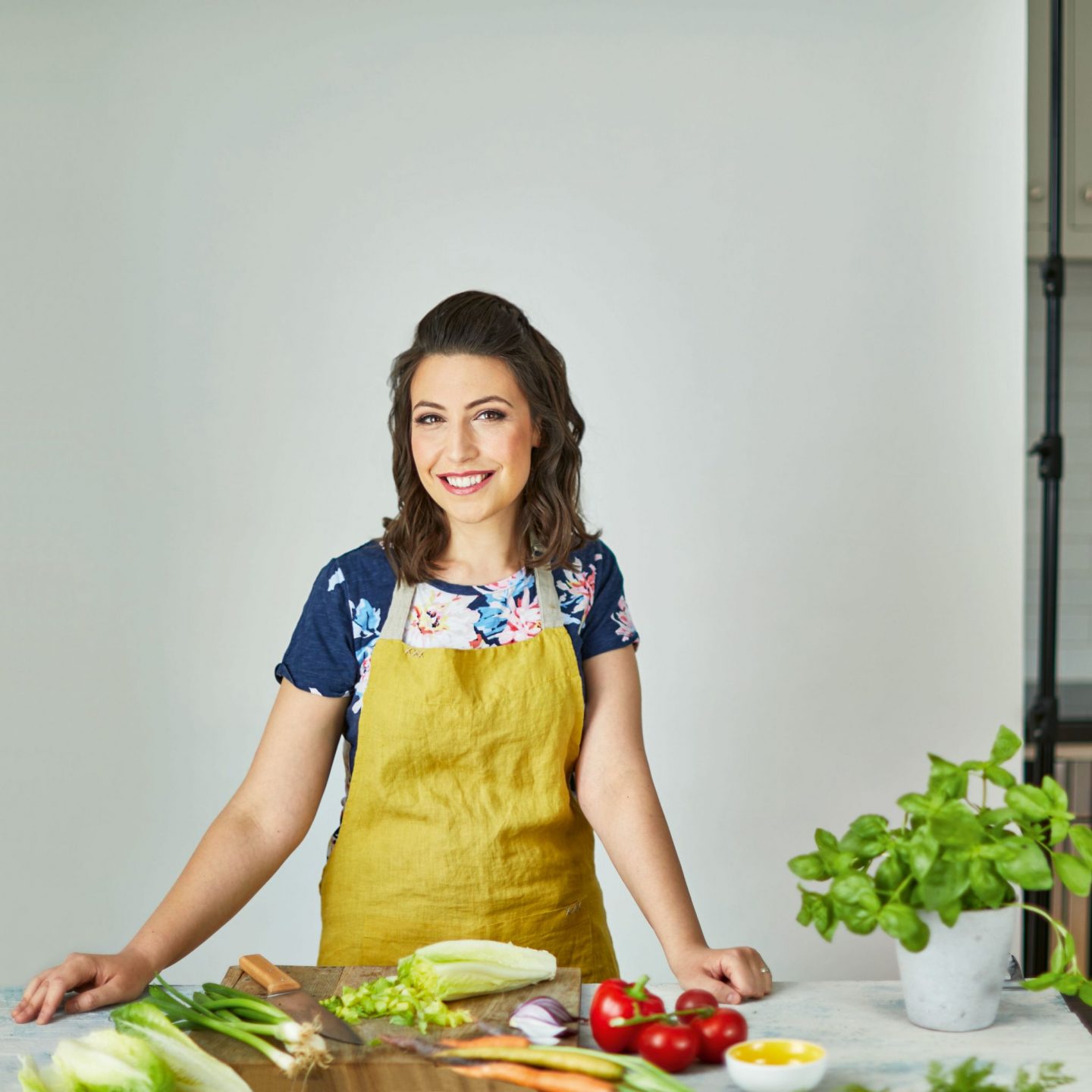Is it possible to Get Your Kids to Eat Anything? According to food writer Emily Leary, there’s not a secret, but there is a method to encouraging your children to eat a wider variety of foods. In a few days time, she’ll publish a book with that very title to prove it.

Emily’s book is a mix of advice on how to introduce youngsters to unfamiliar foods, ideas for having ‘cooking adventures’ with your family, shopping lists and also recipes. It is important to stress it is much more than simply a recipe book.
Emily was kind enough to give me a copy and I’ve been making use of it for the past few weeks. Based on my experiences so far, I think Emily’s five phase plan (see below) makes a lot of sense. I would thoroughly recommend making the chicken and vegetable black noodle sir fry and pineapple bowl smoothie, which was a massive hit with my daughters, Helen and Izzy.
As a child, I was a notoriously fussy eater and it was a concern of mine that my own offspring could follow in my footsteps. Thankfully, my own children are not hugely picky eaters but I feel for anyone who does struggle to get their children to enjoy food and I see real value in this title.
Emily, who is well known in food and family blogging circles as the individual behind the blog amummytoo, was kind enough to agree to be the latest person to feature in my ‘Dadbloguk Q&A’ series. Here’s what she had to say.
Emily, can you please tell us a bit about your background. Tell us about your family and how you got into cooking?
I’m mum to two very tall kids: a son JD (11) and daughter Jay (7). I’m also wife to Mark and we all live in Nottingham.
I grew up cooking with my mum, Mave, and then began making family meals independently at the age of 11 when my mum was moved onto evening shifts, so I’ve always been comfortable in the kitchen.
However, my day job straight out of uni was in PR and marketing, so I spent over a decade doing a job that had nothing to do with food! It was blogging that took my passion for cooking from hobby to career.
I was on maternity leave with my daughter when I set up my food and family blog, A Mummy Too in 2011.
I wanted to make the most of my time with JD before Jay came along, so we were baking together, doing crafts together, going on outings and whatever else we could think of. All the while, I was taking photos to preserve the memories.
I set up the blog totally on a whim one night, thinking it would be the perfect place to record our adventures. My approach was to show what we were doing in a how-to style so that other parents could try our ideas, experiences, recipes and crafts for themselves.
I didn’t expect many people to read it, but it took off incredibly quickly. I think the fact that I went back to work soon after Jay was born also played a part in its success, as it meant that a lot of the activities and experiences were, by necessity, quick and simple, so they resonated with busy families.
After a couple of years of cooking at the weekend and writing recipes up in snatched midnight moments while feeding my daughter, or in the loos at work over lunch, I took the plunge and went full time. I’ve never looked back.
Is it fair to say your blog, A Mummy Too, inspired you to write your new book How to Get Your Kids to Eat Anything?
Absolutely. The community that has grown around my blog has given me incredible insight into what parents really need to know, what they want to cook and the approach they need to make that happen.
I wanted to put together a book that tackled their most burning questions and offered tried-and-tested solutions, so that was my starting point.
It’s also borne out of years of cooking for my own children; the successes, the failures, the learnings and the breakthroughs.

You’ve made clear your book isn’t simply a recipe book. It’s quite a bit more than that and includes a fantastic five-point plan for encouraging children to be more adventurous with their food (….possibly even adults!). Can you provide an outline of the five points?
Yes! I wanted to do more than just arm parents with 70 new recipes and send them on their way, so I created a 5-phase programme that aims to foster the whole family’s enthusiasm for a variety of ingredients and meals through a host of activities, challenges and really tasty, family-friendly recipes.
Here’s how the programme works.
- PHASE 1: PUT THE UNFAMILIAR INTO THE FAMILIAR: Introduce elements of unfamiliar colour, flavour or texture into family favourites. Think spinach “meatballs” or lentil bolognese.
- PHASE 2: EDUCATE: Experiment with texture, taste and smell. Look into the science of taste, understand where food comes from and grow your own.
- PHASE 3: DISCOVER THE FUN IN FOOD: Build a new level of enthusiasm for variety with creative, exciting dishes such as pancake plate art and bright red risotto.
- PHASE 4: STEP INTO THE UNKNOWN: Push food boundaries with surprising flavour combinations, such as strawberries and cream pasta!
- PHASE 5: CEMENT VARIETY: Now it’s time to make sure the habit sticks. Learn techniques to keep your family mealtimes varied long-term.
In the intro to your book you tell a very interesting story where your mum noticed your son was favouring foods that were coloured orange. What other warning signs should us parents look out for that we may unwittingly be nurturing fussy eaters?
Most of us have witnessed the list of things our child will eat getting narrower and narrower and felt powerless to do anything about it.
The trap we busy parents tend to fall into is serving the things we’re sure our kids will eat time and time again.
That can be very practical; no one likes to see their carefully cooked meals rejected by the kids! It can lead to a very narrow view of what children think of as normal. And then anything unfamiliar is viewed with suspicion.
Take, for example, a battered white cod served every Friday. Great. But try to serve up a piece of grilled salmon and it can be a tough sell: it’s the wrong colour, it smells funny, where’s the batter?!
So the core aim of Get Your Kids to Eat Anything is to turn that idea of normal on its head. To gradually introduce variety and to keep that going day after day, week after week until the experience of discovering new flavours, textures, smells, shapes and colours on the plate is the new normal.
What other tips would you give mums, dads and carers struggling to feed their kids?
In the book, as well as taking parents through a series of meal plans to gently and increasingly challenge children’s perceptions of food, there are also lots of activities to help foster understanding, engagement and enthusiasm.
From growing your own herbs to learning about the main food groups, to exploring ways to create fun on the plate, it’s all about really strengthening the whole family’s relationship with food, so whether you just make a little extra time to help the children get involved in cooking, or head to a pick your own farm at the weekend, anything you can do to enjoy food together as a family is a great thing.
What are the main mistakes families make that encourage fussy eating?
First of all, please don’t worry! If you’re ever concerned about your child’s health then, of course, you should chat to your health visitor or pop and see your GP. For most, picky eating is something you can tackle as a family and have fun doing it!
Creating good habits doesn’t happen overnight, so stick with it and stay positive so that any worries aren’t communicated to your children. Relax and keep doing your best. They’ll come around with time.
In terms of mistakes, I was thinking back to when my daughter was a little younger and she’d try the craziest combinations – like dipping a cheese and onion crisp in strawberry yogurt. And our natural reaction is to say, “What are you doing?!” but actually, when we take a step back, it’s clear to see that we should be celebrating and encouraging that adventurous attitude to food, so that’s an easy adjustment to make.
Other than that, as I say I think the main pitfall we all tend to fall foul of at one time or another is serving up an increasingly narrow selection of meals to our children, thereby perpetuating an ever decreasing circle.
How to Get Your Kids to Eat Anything features some great recipes, many designed to get unfamiliar ingredients into familiar foods (the peanut butter pizzas being a favourite of mine!). How did you come up with these dishes?
Feedback from hundreds of parents really helped. For example, during research for Phase One (‘Put the unfamiliar into the familiar’), I asked what their favourite family meal was that the whole family enjoyed. The most popular dishes became the inspiration for those recipes, but with a twist.
Similarly, Phase Two is all about educating your family about food, so the recipes incorporate some of the fruits of those challenges. Phase Three is all about fun so I created recipes with unusual looks, colours and tastes, and by Phase Four, the recipes are really designed to stretch everyone’s imagination with some really unusual but delicious dishes.
Phase Five is slightly different from the others, as it offers recipes that give parents the tools to be creative with food in the long term, so there are some tasty recipes for soup, bread, using up leftovers and so on, but also lots of guidance about how to get experimental with them for years to come.
There’s a lot in the book about meal planning which is a personal failing of mine. Why is it so important?
When I started meal planning, it really turned our approach to mealtimes around. When you sit down and plan your main meals for the week, it gives you space to think more intelligently about what you eat, build in a better nutritional balance and save money by only buying what you’ll need.
At the beginning of the book there’s a chapter called ‘Preparing to Begin’ in which you list essential ingredients to keep in any kitchen. Can you pick five items from that list that absolutely everybody must have?
Herbs and spices, dried pasta and rice, a good range of canned beans and pulses, lots of fresh veg, and a well-stocked freezer!

Children can easily get involved with many of these recipes. I have heard parents say they don’t really have the patience to cook with their kids. Why do you feel it is so important (just have to say I really enjoy cooking with my kids!)?
There’s no denying that modern parenting is hectic, but cooking together can actually make life easy as it means the kids are busy and entertained while you make dinner. And of course, it’s a chance to chat as you cook, hone their motor skills, and build their understanding and positive relationship with food.
My kids will eat all manner of foods at school where they have school meals. Why, in your opinion, do kids become instantly more fussy when they are served food at home because this is something I’ve heard from a few parents?
At school, they expect to be given one, maybe two, meal choices each day and to eat what they’re given, so that’s their normal. At home, they are probably used to having more choice, to being able to snack from the fridge, and they’re probably pros at persuading mum or dad to cook their favourites, so that’s their home version of normal!
What next for Emily Leary? Are we going to see a TV show? Your own restaurant of café chain? Your own food range?
Well, hopefully, the book will be a storming success and then yes, I’d absolutely love to take the concept to TV and work with families to show how we can all bring variety into our mealtimes.
Get Your Kids to Eat Anything
As mentioned above, I have been delving into Emily’s book and had some successes. If this Q&A has inspired you, Get Your Kids to Eat Anything by Emily Leary is published by Mitchell Beazley and has an RRP of £16.99. It’ll be hitting the book shelves on 21 March but can be pre-ordered online.






